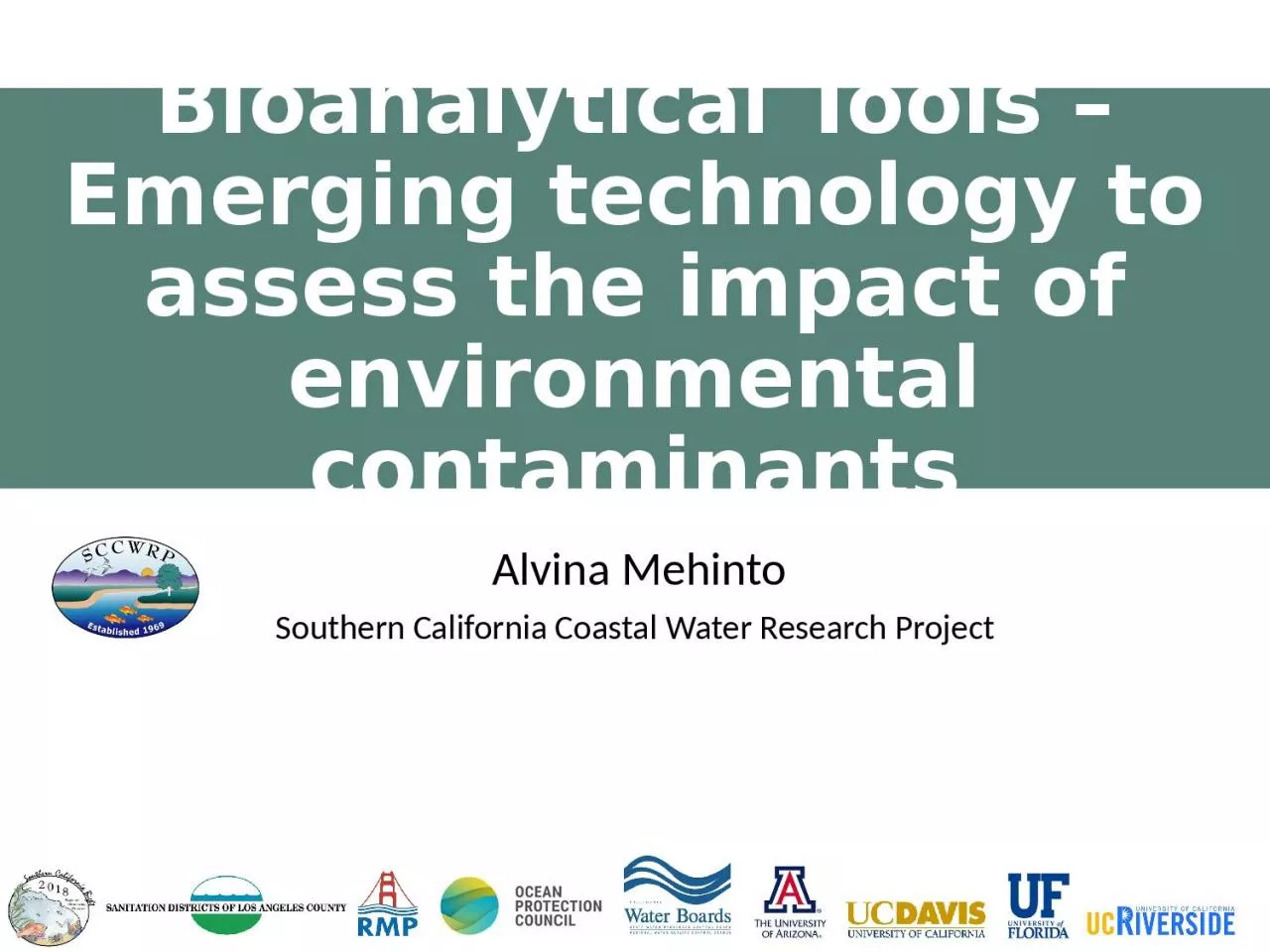

Alvina Mehinto Southern California Coastal Water Research Project Monitoring for CECs is a moving target Current monitoring focuses on a small portion of known chemicals No mechanism to address unexpected chemicals ID: 1036390
Download Presentation The PPT/PDF document "Bioanalytical Tools – Emerging technol..." is the property of its rightful owner. Permission is granted to download and print the materials on this web site for personal, non-commercial use only, and to display it on your personal computer provided you do not modify the materials and that you retain all copyright notices contained in the materials. By downloading content from our website, you accept the terms of this agreement.
1. Bioanalytical Tools – Emerging technology to assess the impact of environmental contaminantsAlvina MehintoSouthern California Coastal Water Research Project
2. Monitoring for CECs is a moving targetCurrent monitoring focuses on a small portion of known chemicals No mechanism to address unexpected chemicalsRelevant toxicity data is limitedMixture effects is of concernPrioritizing CECs and establishing relevant monitoring thresholdscan be difficultPyrethroidsDDTsPFASs
3. Effects-based monitoring as an alternativeTiered framework to:Supplement chemical-by-chemical monitoringImprove understanding of mixture toxicityEndorsed by California State Water BoardNon-targeted chemistryTargeted chemistryBioanalytical cell assayLab (animal) toxicity testField surveyWhich chemicals should be prioritized?Which toxicity pathways are of concern?
4. Cell bioassays - backgroundRapid, cost effective method to screen for multiple chemicals simultaneouslyEngineered to represent key biological pathwayi.e. potential link to adverse effectCombined measure of all chemicals with same biological activityCurrently used by pharmaceutical, cosmetic and food industries; and for chemical registration by USEPA
5. Cell bioassays- MechanismMammalian cells engineered to track cellular responsesCells and sample extracts are added to each well, and incubatesLight intensity is proportional to the concentration of bioactive chemicalsResults expressed as equivalent concentration relative to a known chemical
6. Candidate cell bioassay endpointsBioassaysAssociated toxicityKnown chemicalsEstrogen receptor alpha (ERα) Feminization, impaired reproduction Estrogens, alkylphenolsAryl hydrocarbon receptor (AhR)Developmental anomalies, tumorsDioxin-like compounds, PCBs, PAHsGlucocorticoid receptor (GR)Impaired immune functionsAnti-inflammatory steroidsPeroxisome proliferated-activated receptor (PPAR)Metabolic disordersPharmaceuticals, phthalates
7. Cell bioassays for environmental monitoringGoal is to develop a comprehensive set of cell bioassays Widely availableRobust protocols with performance based acceptance criteriaConsistent with monitoring goalsMonitoring trigger levelsEndocrine disrupting chemicalsEstrogen receptor alpha (ERα)Glucocorticoid receptor (GR)Anti-androgen receptor (anti-AR)Carcinogenic chemicalsAryl hydrocarbon receptor (AhR)Tumor protein P53 response element (P53RE)Immunosuppressants and neurotoxinsThyroid receptor (TR)Peroxisome prolif. activated receptor (PPAR)Acetylcholine receptor (AchR)
8. Key research questionsWhat is the sensitivity of cell bioassays?Can they discriminate between “clean” and contaminated samples?Do bioactivity patterns make sense?Are cell bioassay data in agreement with other lines of evidence?
9. Our approachTesting of various samples typesWastewater influents and effluentsAmbient waters (stream, river, stormwater)Advanced treated water (microfiltration, reverse osmosis…)SedimentCell bioassay screeningERα, AhR, GR bioassays Comparison with other lines of evidenceTargeted, non-targeted chemistry dataLab toxicity data, biological indices
10. Bioscreening of effluent-impacted riversSamples from 8 wastewater treatment plants and ~30 sites in receiving waters throughout CaliforniaBioactivity patterns reflected the level of treatment and concurred with available water quality data
11. Reproducibility of results We have participated in several intercomparison exercisesBlind analyses of water sample extracts using commercially available assaysFive laboratories with different level of expertiseData quality evaluated based on set of QA criteria (e.g. calibration, blanks, cytotoxicity)
12. Bioscreening of coastal & marine sedimentPart of Bight 18 regional survey which aims to assess:sediment qualitybenthic communitiesfish health and bioaccumulation ocean acidification and algal toxins
13. Cell bioassay for site prioritization …Study aimed to evaluate extent and magnitude of bioscreening responsesHighest AhR bioactivity levels were found in estuariesOnly 1 sample from Channel Islands had quantifiable AhR bioactivity
14. … and guiding further testingOverall, good agreement between AhR bioactivities and ∑PAHs measuredLess so with toxicity dataBut >75% of samples with no/low bioactivity were nontoxicDifferences in test sensitivity & endpoints could explain the discrepancies
15. Linking cell bioactivity to aquatic healthArea of ongoing research globallyUnderstand the relationship between biological events at the cellular and whole organism levelsDevelop monitoring trigger values protective of aquatic lifeWe are using an Adverse Outcome Pathway conceptCell receptor activityAltered genes/ proteins levelsChemical exposureTissue damageWhole organism changes lowest conc. for --> 10 × ? --> lowest conc. for bioscreen response animal response
16. – Example – In vitro / in vivo estrogenic responsesExposuresLab-based: single chemicals and effluent dilutionsField-based: effluent impacted riverBiological modelsFish: fathead minnows and Menidia silversidesCell assays: ERα GeneBlazer (LifeTech) EndpointsChemical conc. and bioactivity in water Gene/protein changes in fish tissuesDevelopment, reproduction, survival
17. 28-d exposure of juvenile silversidesAnimal responses at conc. 5-25 x higher than cell assay responsesUsing AOP knowledge to screen for toxicityERa bioactivityIncreased vtg/chg gene expressionImpaired gonad developmentReduced growthEC10 – 8 ng/LEC10 - 16 ng/LBEQ <5 ng E2/L200 ng/L100 ng/LNo increase 200 ng/L300 ng/LNo effect observed> 500 ng/L> 300 ng/LNo effect observedE2E1Effluent dilution
18. 21-d exposure of adult fathead minnowsAnimal responses at conc. conc. 2 x higher than cell assay responsesStudies confirm our hypotheses that cell bioassays could serve as protective screen for toxicityUsing AOP knowledge to screen for toxicityERa bioactivityIncreased vtg gene expressionAltered sex characteristicsReduced reproductionEC10 – 8 ng/LBEQ <5 ng E2/L18 ng/LNo increase 54 ng/LNo effect observed180 ng/LNo effect observedE2Receiving water
19. Lessons learnedAdapting cell bioassay for environmental monitoring is possibleCapable of discriminating among water qualitiesStandardized protocols available for reproducible resultsEffects-based monitoring could streamline existing practicesPrioritization of sites requirement further testingImproved toxicity assessment of chemical mixturesEstablishing in vitro effect thresholds protective of aquatic life is possible
20. Towards application of cell bioassaysInternational experts have recommended the use of cell bioassays for water quality monitoringFirst application focuses on diagnosis/prioritization of chemicals of concern
21. Questions?Questions?Alvina MehintoPrincipal Scientist in Ecotoxicology(714) 755- 3210alvinam@sccwrp.org